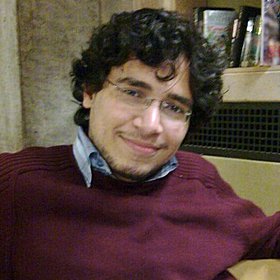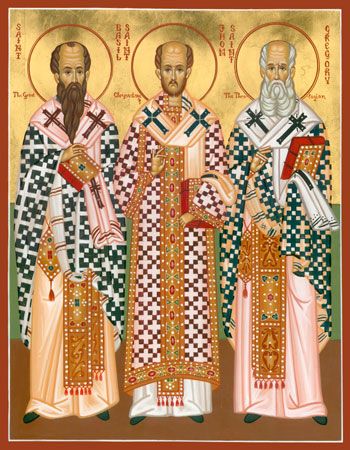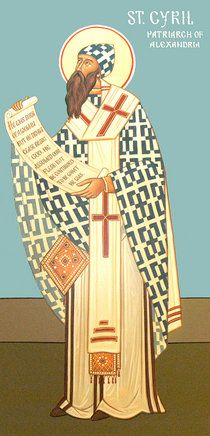|
From 'Orthodoxy and the World' www.pravmir.com History of Christianity Part II - a Historical and Doctrinal Premises
Exclusive to Pravmir
Edited by Elizabeth J Iskander
In the previous article, I discussed the problems that subverted the Ecumenical dialogue. I tried to analyze why the approach led to a dead end and called for a fresh start with a proper approach. In brief, I referred to the fallacy of the attempts of reducing the difference between the Orthodox and Monophysite Christologies to be merely a terminological misunderstanding. Readers should note two points; first, this article sheds light on major facts but doesn't produce an intensive study on them. Secondly, it should also be known to the reader that the following ideas shed light on the fundamental issues that have been, most probably deliberately, overlooked by the two sides of the Joint Commission of the dialogue. Origins of Monophysitism: a history of the one-nature formula Monophysitism is not a term that has been literally used by Monophysites. In fact, it was later used by scholars to describe a way of thinking that led people to what is called believing in the One-nature. This belief is described by a Greek formula Mia-physis which means the One-nature. The first objection of the Monophysites is the distinction made between mono and mia. The former is the prefix of the name Chalcedonians use to describe the non-Chalcedonian faith, while the latter is the one used in the formula non-Chalcedonians themselves use. They argue that the difference between the term Chalcedonians use, that is mono, and the term used by the non-Chalcedonians, that is mia, shows the inaccurate approach in describing the faith they hold. Actually, Monophysitism is a technical name used to describe the common factors in their various shapes of belief found in Eutychus, Dioscorus, the Severans (Severus and his followers) and later the non-Chalcedonians. Whilst they all reject Orthodox Christology they do not share the same system of belief. In any case, we need to start to understand the origins of the Mia-physis formula and the core of Monophysitism within it. Regarding the authenticity of this formula, Monophysites believe that it has been used by the Fathers to describe the unity of Christ's nature into one incarnated nature. Historically, we can't find any of the Fathers of the Church using such a concept. The prominent 20th century English Patrology scholar, Henry Chadwick, sheds light on how the language and Theology of mia-physis from Origen's examples were later used by Apollinarius and then, as we will see, the radical Monophysites.[1][2] In his confession of faith, Eudoxius, the Arian bishop of Constantinople, provides us with the earliest known use of the one composite nature Christology. He says: "We believe in … the one Lord, the Son… who became flesh, but not man. For he took no human soul, but became flesh so that God was revealed to us men through flesh as through a curtain, not two natures, since he was no complete man, but God in the flesh instead of a soul; the whole is one nature by composition."[3] The same idea can be found in the words of Lucian, another Arian figure who was the bishop of Alexandria from 373-378.[4] However, the earliest known usage of this term was by the most famous heretic in history and his followers, by that I mean Arius. This mia-physis minimizes not only Jesus’ divinity but his humanity by excluding a human soul from his human nature.This was later to be known as the apollinarian heresy preached by Apollinarius of Laodicea. In his zealous defense against Arianism, Apollinarius used the same language in the pattern forming his teaching. To preserve the single personality of Christ, Apollinarius considered that the human mind and soul can form together another person, so, to avoid having two persons or subjects in Christ, he denied the existence of a human soul or rational mind stating that the Logos (the hypostasis of the Son) filled these gaps in the human nature.. That's why he was the first to preach within the Catholic Church the term of one composite nature, the synthetos mia-physis.[5] Eventually, by the end of the fourth century, Apollinarius had ensured the transformation of the mia-physis term from a mere expression into a complete solid formula. That formula was the one used later by Monophysites who stick with it till today excluding any other formula and teaching. Apollinarian writings developed until it reached this controversial sentence: "Thus, the Lord existed not in two substances but in one … Orthodoxy could be summed up in the formula One Incarnate Nature of the Logos - Mi&a fu&sij tou Qeou lo&gou sesarkwme&nh"[6] This extravagantly fashioned formula had been received negatively by the whole Catholic Church since it undermines the unity and solidarity of the Son with our humanity. "What has not been assumed cannot be restored, what is saved is what has been united with God" says St. Gregory of Nazianzus.[7] The shocked and disappointed Athanasius of Alexandria who thought for once that Apollinarius was his ally against Arianism wrote several treatises against his belief, while the Cappadocian Fathers and Rome started writing against what was called then an "awkward" formula and teaching. This composite One-nature preserved an illegitimate and deformed Christology. St. Gregory of Nyssa said: "If, then, the nature of each of these is to be observed in their opposite properties - I am referring to the properties of flesh and of divinity- how can the two natures be one?"[8] St. Gregory of Nazianzus said: "The combination is one; however, it is not one by nature, but by union."[9] The problem escalated when the Fathers did not only criticize the usage of this formula, but also condemned it. Eventually, Apollinarianism was condemned in the first canon of the third Ecumenical Council in Constantinople. So as not to leave any room for using this formula even apart from Apollinarianism, St. John Chrysostom who was the Archbishop of Constantinople,[10] the highest throne in the East, along with saint Ambrose of Milan[11] in the West, wrote a warning against using this "awkward" formula and condemning anyone who uses it. The question is how this formula, with the minimized concept of humanity it holds, found its way into the writings that Monophysites rely on to proved their patristic authenticity? Let's crack this riddle. Under the sponsorship of Emperor Justinian, an intensive dialogue between the Chalcedonians and non-Chalcedonians throughout the Eastern Empire began. It reached its climax in the 530s, when the systematic theologians and scholars of Constantinople and Rome directed debates with the Severians. The shocking argument that startled the Severians was the result of intensive textual investigations of the patristic writings, which led to the conclusion that the texts mentioning the mia-physis formula was falsely attributed to great Fathers of the Church like Saint Athanasius, and that these writings are nothing but Apollinarian forgeries. [12] In brief, Hypatius of Ephesus and the great scholar Leontius of Byzantium made a great contribution in comparing the texts of Apollinarius with the alleged pro-Miaphysis texts of Athanasius, Julius of Rome and others. From the days of ancient Greek philosophers until the medieval ages, it is known that several writings authored by unknowns or heretics have been transmitted via labeling them with famous names., The famous examples in Christianity are the gnostic gospels that had been attributed to the Apostles while they were actually written in later centuries. Apollinarian’s forgeries saved the thoughts and formulae of Apollinarius using names like Athanasius the Great and St. Cyril, who himself complained about the spread of fake writings attributed to Athanasius and himself. This led to the infiltration of Apollinarian language (including the controversial formula) intto his writings and caused severe damage between Alexandria and Antioch since the Antiochians know very well the writings of their own Bishop of Laodicea, Apollinarius. However, that was too late. The radical stream coming from the south and led by the a monk named Shenouda who destroyed the temples, persecuted and burnt everything against him to the ash, managed to win the support of the Egyptian monks and the radical stream, including Dioscorus,[15] who was to become the next patriarch. "Dioscorus", says the Professor of Ecclesiastical history at the University of Edinburgh "has gone down as one of the great villains of ecclesiastical history".[16] An armed militia[17] guarded his dreams and his new radical ideology held to Monophysitism firmly. In this way, the Alexandrian Throne, the most influential in the East, became the pulpit from which Monophysitism was preached, whereas this formula should have been stopped in a small city in Asia Minor called Chalcedon. In the next article, I'll discuss the theological legacy of the Monophysites and the Orthodox Church, and will discuss in detail the crucial role of Chalcedon and post-Chalcedon debates increasing the current situation.
[1] Chadwick H., Eucharist and Christology in the Nestorian Controversy, Journal of Theological Studies, Oxford, n.s.:2(1951) p.145 [2] Cited by Leontius of Jerusalem, Against the Monophysites: Testimonies of the Saints and Aporiae, Translated and Edited by Patrick Gray, Oxford University Press, UK, 2006. P.52 [3] "… ou du&o fu&seij, epei mh_ teleioj hn anrwpos … mi&a to_ olon kata sunqesin fu&sij…" " Aloys Grillmeier, Christ in Christian Tradition, Vol.I, John Knox Press, Atlanta, 2nd edition 1975, p. 244 [4] Ibid. p.245 [5] See his major work Treatise on the Incarnation 6. cf. Aloys Grillmeier op. cit. vol. II part2 p. 358 [6] Apollinarius Ep. Ad. Jovianum I ( Lietzmann pp. 250 - 1 ). Cited by W. H. C. Frend, The Rise of the Monophysite Movement, Cambridge University Press, UK 1979, P.116-117 [7] Ep. 101.7 [8] Pw~j mi&a ai( du&o fu&seij ei(si&n? Gregory of Nyssa , Against Apollinarius , Against Apollinarius , ed. F. Mueller [9] Gregory Nazianzus , oration 30 [10] ‘The moment the divine nature thus dwelt in the body, the combination completed one Son, one person, known in an unconfused and undivided way, not in just one nature, but in two complete natures. In one nature, after all, how could there be unconfusedness? How could there be undividedness? How could union ever be talked about? That is because the one nature cannot be united with itself, or confused with itself, or divided from itself… Let us flee those who make up the fairy-tale of one nature after the union. Through the idea of the one nature they hasten to attribute suffering to the impassible God" John Chrysostom, letter to Caesarius. [11] Ambrose, Explanation of the Creed .G.H. Ettlinger , Eranistes (Oxford Clarendon Press, 1975) , 163. [12] For a further study, See Aloys Grillmeier ibid. p.237 & 358 also, W H C Frend op. cit. p.115 - 120. Philip Schaff discusses with arguments how the apollinarian forgeries have been found in the pseudo Athanasius texts http://www.ccel.org/ccel/schaff/npnf204.v.iii.i.html [13] Cyril of Alexandria Letter 53 to Xystus , Bishop of Rome, PG76
" Oi}da de_ kai_ apaqh~ th_n tou~ qeou~ fu&sij kai_ a!trepton kai_ analloi&wton ka)n th~ th~j anqrwpo&thtoj fu&sei , kai_ e#na e)n a)mfoi~n kai_ e)c a)mfoi~n to_n Xristo&n "
[14] Epistle XXXVII, to Theognostos, Patrologia Graeca, Vol. LXXVII, Col. 169C; quote in The Non-Chalcedonian Heretics, p. 12
[15] Dioscorus, The Egyptian Patriarch of Alexandria said: " This Country 'Egypt' belongs to me more than the emperors and I request Sovereignty over it." [cited by Jaques Tagher, Christians in Muslim Egypt, Oros Verlag 1998, p.3]. The patriarch and Coptic priests like Shenoute from the 5th century led campaigns against their enemies, destroying pagan temples and punishing opponents by expelling them from their houses and properties. See: Michael Gaddis, There is no Crime for those who have Christ, University of California Press 2005. [16] W. H. C. Frend , op. cit. p.26 [17] This name in Greek " Ðáñáâïëᾶíïé" which means volunteers for christ. According to codices Theodosianusxvi, 2, 42. and Justinianus I, 2, 4. they were acting in help of the sick and poor, and later they became the guards of the Patriarch who played the violent role in various events as a militia © Copyright 2004 by 'Orthodoxy and the World' www.pravmir.com |


